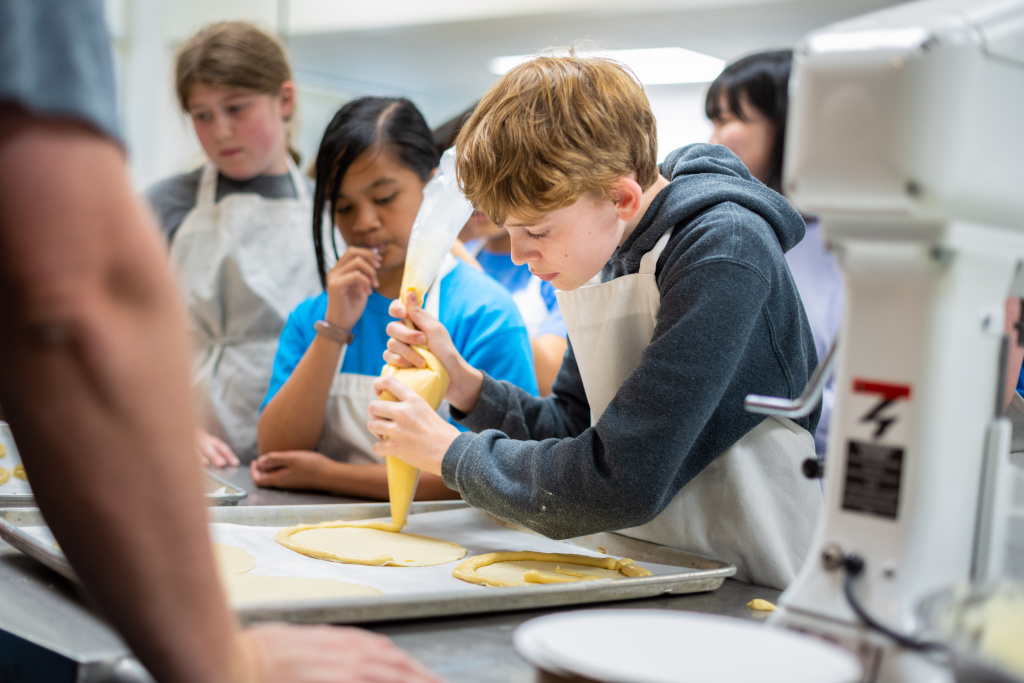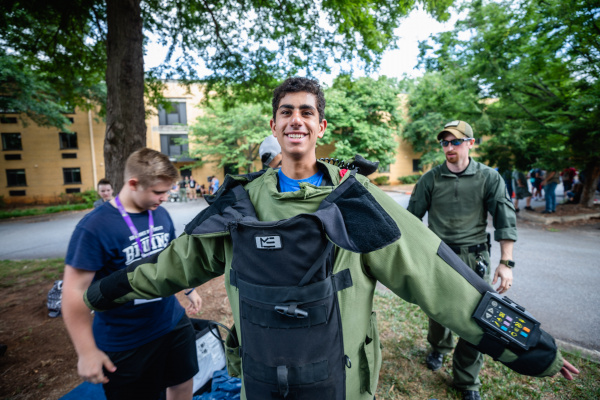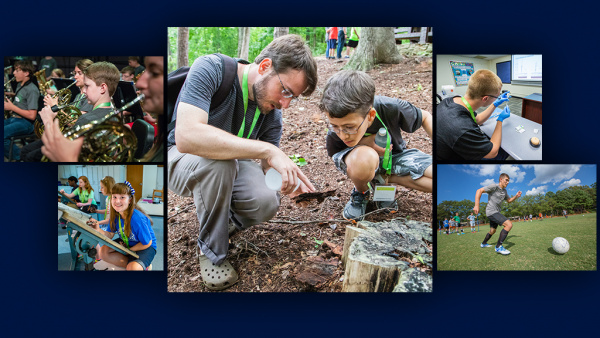What do fairy tales, cream puffs and the legend of the croissant have in common? The Pastry Perfection EDUcamp Jr. weaves together different subject areas to create an engaging story of the art of food. This week-long camp incorporates faculty-guided, hands-on learning experiences that encourage creativity and produce tasty treats.
Faculty Adapting
The BJU faculty that run the Pastry Perfection EDUcamp successfully adapt to elementary school and middle school campers.
Incorporating Other Subjects
Faculty connect the world of pastries with other subjects that fascinate campers. Dr. Paul Radford, a faculty member in the University’s department of communication studies, opens the day with talk of fairy tales. Fairy tales in a culinary camp? Yes.
He reminds the campers of the plot in Andrew Peterson’s The Wingfeather Saga, drawing stick figures on the whiteboard that represent the main characters. Radford reads from one of the books, choosing selections that focus on food.
He explains the deeper purpose of food — it brings people together, dissolves barriers and meets physical needs, opening the door for compassion and sometimes paving the way for gospel conversations. He shares a real-world experience from his life that demonstrates these applications.
Chef Dave Miller, who teaches in the University’s culinary arts program, folds and stretches laminated dough in front of the campers as he tells the legend of the croissant. Although no one knows for sure which story is correct, Miller emphasizes that knowing about other subjects will help the campers be better bakers.
Chef Rob Hansen, the program coordinator for the culinary arts program, demonstrates how to make pastry cream using an induction burner. Explaining the science behind magnetism, he safely slides a piece of paper between the pot and the burner, much to the campers’ amazement. The campers gather around the counter and ask questions of the chef. When the cream is done, they line up with plastic tasting spoons in hand to try the treat.
Incorporating a Variety of Methods
Additionally, faculty connect the world of pastries through teaching methods that engage campers. Miller previews the day’s menu via Powerpoint pictures: pâte à choux, a chocolate demonstration and laminated bread. Through discussion, the campers learn that pâte à choux means “dough of cabbage” and can be made into beignets (a New Orleans special), churros, cream puffs, swans and croquembouche (a towering cone of puff pastries secured by spun caramel).
In preparation for the demonstration later that day, the campers watch a video about how chocolate is made, followed by a mesmerizing clip about a baker in England who’s challenging the traditional model by baking throughout the day.
While his group waits to pipe the pâte à choux, Radford mixes a five-ingredient butter cookie on the table with his bare hands, spreading the ingredients in rings around the egg in the middle. “That was one of the most fun things because we didn’t use a mixer,” said Tyler, a camper from Greer. “We didn’t use really any machinery, and we just used our hands.”
Hands-On Experience
The campers receive their own aprons and wash their hands before working with the dough. They pipe the pâte à choux on pans, making big globs for cream puffs, small blobs for their croquembouche and lines for ladyfingers.
Ben Snyder (’11), the owner of Lumineux Chocolate, shows the campers how he makes chocolate. He passes around cocoa beans for everyone to crack and taste the nibs inside as he explains the origins of the beans he roasts and ferments at Lumineux. Volunteers from the group add the beans and other ingredients to the tabletop machine that blends the chocolate together. The smell of chocolate fills the air as a camper adds the last ingredients.
Snyder passes around three samples of his chocolates for the campers to taste. The first is a 45% blend from Congo beans; the second a 68% from Uganda beans; the last a 75% from Tanzania beans (the same the campers made). He asks the campers about the specific flavors they taste and answers any questions they have.
See Also: Tour of Culinary Arts Alumni
Next, the campers don their aprons again and go into the kitchens. They bore holes into their cream puffs and fill them with pastry cream. As they wait for the chocolate topping for their puffs to cool, they make danishes from the laminated dough. Some campers create the danish designs that Miller showed while others invent new patterns. They pick from four filling options and set their masterpieces on the pan.
The campers clean their areas and wash the dishes while they wait for their danishes to bake and cool. Then, they bring their cream puffs to be drizzled in chocolate and choose a first, second and third place danish from the finished products. After all dishes are washed and all treats are collected, the campers take their box of goodies home to enjoy.
Campers’ Reflections
EDUcamp may sound fantastic from the outside looking in, but what do the campers themselves think? A few campers shared their thoughts and favorite things from camp in their own words.
Tyler from Greer has attended many EDUcamps — two years ago he went to every EDUcamp offered — but his favorite was the robotics camp. About Pastry Perfection he said: “I love baking, and I wanted to find some other things to do for … Friday movie night. My mom won’t have to make everything, so that way I can help her with it and just make some desserts.”
Judah from the Greenville area said: “This year I’ve been watching ‘Kids Baking Championship,’ and I’ve had the joy of cooking. I love it.” Although Judah has been to every year of basketball camp since first grade, he enjoyed making the strawberry shortcake and eating the food he baked. “I just love it so much,” he said.
Julianna from Brevard, North Carolina, came to EDUcamp for the first time this year. She said that her dream job is “either baking or I want to be a zoologist.” She loved making the cookie cakes with chocolate icing.
Whether they’re listening to fairy tales, tasting yummy treats or experiencing the chocolate-making process first-hand, campers can explore their interests through an age-adapted culinary EDUcamp. EDUcamps allow campers to try new things in a fun environment that encourages creativity and expands their horizons for the future.
See Also: Exploring Your Future Through EDUcamp
For more information about EDUcamp, visit the website.








